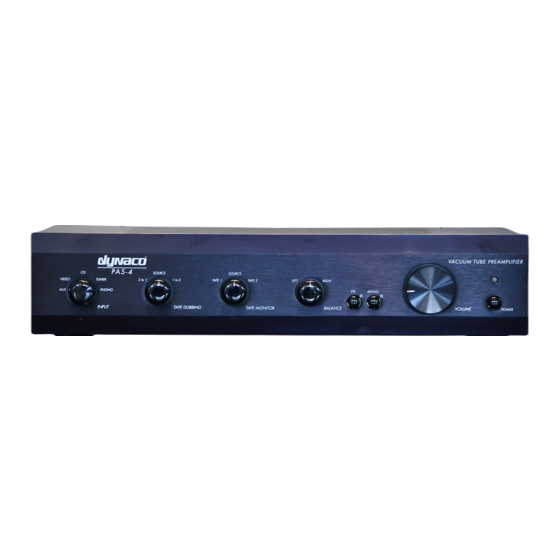DYNACO PAS-4 Owner's Manual - Page 5
Browse online or download pdf Owner's Manual for Amplifier DYNACO PAS-4. DYNACO PAS-4 15 pages. Vacuum tube preamplifier
Also for DYNACO PAS-4: Owner's Manual (16 pages)

Operation
Turn-On Delay and Visual Indicator
When you turn on the PAS-4, the lamp above the PWR (power) switch glows GREEN and a timer circuit
is evoked which keeps the preamp outputs at zero volts during the warm-up period. This 45-second
warm-up period allows the tube filaments to fully heat, the high-voltage section of the power supply to
reach full potential, and for the preamp output circuitry to settle, (avoiding loud turn-on "thumps"). When
warm-up is finished, the lamp turns to RED and the preamp outputs are operative.
When you turn off the PAS-4, the outputs immediately clamp to zero volts. Turning the preamp back on at
this point will require, again, waiting through the warm-up period.
Input Selection
Your choice of a signal source is indicated by the INPUT switch position you select. This signal source is
what you will hear. It is also sent to the Tape (recording) Outputs and the EQ Outputs, (as long as the
TAPE MONITOR and TAPE DUBBING switches are both set to SOURCE).
Tape Deck Selection - Listening
You may bypass the INPUT switch selection by using the TAPE MONITOR switch, in which case the
signal from the selected tape deck is what you will hear and what is sent to the EQ Out jacks.
When the TAPE MONITOR switch is turned to Tape 1 or Tape 2, what you hear is the signal from the
tape deck playback head, not the original source signal (which is being recorded onto tape via the tape
deck record head). This feature allows direct comparison of the signal source with taped replica without
affecting the recording process. (If a tape deck does not have separate record and playback heads, then
the signal you hear when using the TAPE MONITOR switch is the same signal being sent to the tape
deck to be recorded.)
The following controls affect all signals which are heard through the speakers.
They have no effect, however, on signals being recorded at the Tape Outputs.
EQ Switch
Pushing IN the EQ switch inserts a signal processing device into the preamplifier signal path (if such a
device is connected to the EQ Inputs and Outputs). This part of the signal path is then called the External
Processor Loop (EPL). Such devices include equalizers, time delays or ambiance simulators, expanders,
compressors, and noise reduction systems. When the EQ switch is in the OUT position, any equipment
plugged into the EQ inputs is effectively removed from the preamplifier signal path. Therefore, an
unpowered device connected to the EQ Inputs and Outputs will not deteriorate the PAS-4's performance
(which can happen with some tape decks, as mentioned above).
Note:
The EQ inputs can also be used as a second set of Auxiliary Inputs - (for a second tuner, second
CD player, etc.) Therefore, the EQ switch itself can also function as an additional input selector.
Mono Switch
When this button is IN, left and right channel information is combined and the composite signal is fed to
both left and right outputs. In this mode the sound image should appear to be centrally located between
the loudspeakers. This switch is useful when listening to monophonic program material. It cancels the
unwanted vertical phonograph modulations which are heard as noise from monaural records.
5
